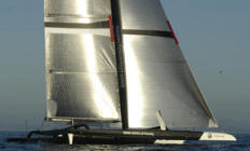America’s Cup trimaran loses her mast during training off San Diego
At around 11am on Tuesday Nov 4, BMW Oracle’s giant America’s Cup trimaran was dismasted, none of the crew were hurt in the incident which happened during training off San Diego (USA).
Moments after stepping ashore skipper James Spithill had this to say.
“We had a mast failure, the mast broke and came down. Nobody was hurt and that’s the most important part. The crew are all safe and all of our support boats and contingencies that are built into the programme really showed today. I just commend the crew and all our support boats for swinging into action. Everyone is back on shore safe and we’ll roll on forwards…
“The weather was actually quite nice. It was relatively light wind speeds and the sea state was quite flat. So until we delve into it and dig deep into our analysis tools, we don’t know what the cause of the failure was…
“The real (sign of) heart in a team is the team that can come back from setbacks. This is a small setback but I have no doubt the team will bounce back… I’m sure we’ll be fine for the race (in February).”
Although standing nearly 200ft off the water’s surface, the mast’s basic configuration was typical of many rotating wing section masts that are used aboard racing multihulls. Supported by a set of upper and lower cap shrouds with chain plates fixed to the outer floats, the shrouds also provide the fore and aft support, working against the forestay and babystay.
Although the scale of this rig would produce some eye watering loads, typically up to 30 tonnes on the genoa tack and around 90 tonnes compression in the mast tube itself, multihull rigs tend to be less highly loaded than those of equivalent sized monohulls due to their wide chain plate bases and their lighter displacement. Nevertheless, with the ability to both cant her mast to windward and take on substantial water ballast, the BMOR 90 is a highly loaded machine.
As a safeguard her entire structure is riddled with strain gauges which transmit data to the performance tender, a data chase boat that shadows the trimaran’s movements during testing. Aboard this boat the design team monitors every load on the boat and informs the crew via VHF if loads are reaching the critical phase. Alarms onboard the boat also alert the crew to any potential problem.
Yet, despite such sophisticated data monitoring systems there is still plenty of scope for problems. Last week during testing a temporary problem with one of the engines aboard the performance tender left the crew of the 90foot LWL trimaran sailing blind as they sailed out of range. Slowing a trimaran that frequently scorches upwind at 18 knots in just 10 knots of wind is not always easy and the distances that the team travels during testing can be considerable. Sailing 30 nautical miles upwind is not unusual.
Whatever the cause of the incident, the dismasting is a reminder that despite the two year long bitter court room dispute, getting around the course will be what wins the America’s Cup and while each team tries to create the most potent boat that they can, reliability will be critical when it comes to the match.
Meanwhile, the court hearing due for tomorrow (Wed) whill now be heard on Friday in which Justice Kornreich will listen to the views of three former America’s Cup jury members in
a number of key issues.




